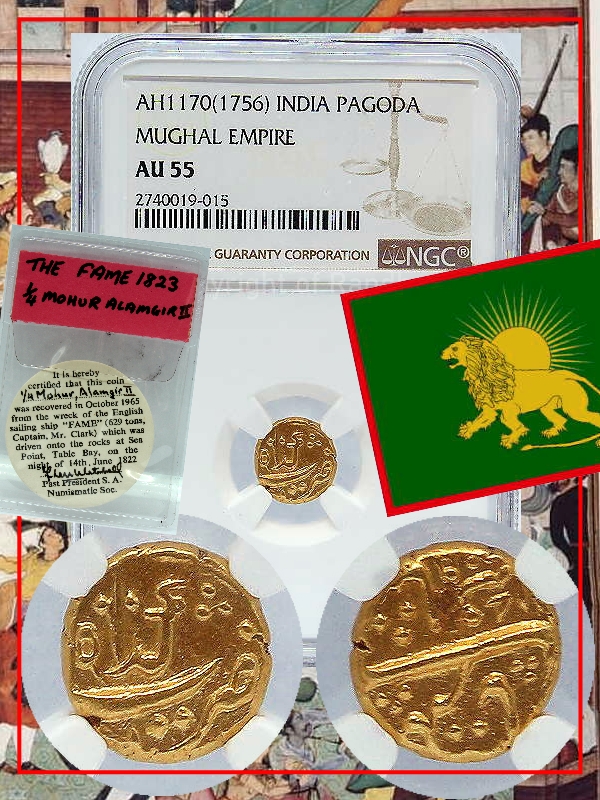|

ref:2020 10 16
kindly view this promotion on the link below if not able to see on the email:
https://www.randcoin.co.za/en/world/1740-to-1807-gold-ms63-india-pagoda-madras
-plus-1756-gold-au55-1756-india-pagoda-mugal-empire-plus-1864-gold-ms63-guatemala-g4r
Dear Collector
FANTASTIC FRIDAY PROMOTIONS
TAKE ADVANTAGE OF THIS WEEKS
FEATURED ITEM CONTACT US NOW
GOLD - HISTORIC VALUE
EARLY SOUTH AFRICAN NUMISMATIC HISTORIC COINAGE CIRCULATING IN THE CAPE COLONY
-----------------------------------
INDIA PAGODA
MADRAS PRESIDENCY
STAR REVERSE
Type: Hammered Coin
"INDIA-BRITISH COLONY COINAGE"
GRADED: MS 63
Background image is of the Bank of Madras
The Bank of Madras was one of the three Presidency Banks of British India along with the Bank of Bengal and the Bank of Bombay.

Composite image is copyright of Randburg Coin only
COIN OF THE BRITISH
INDIA TRADE ROUTES FOUND IN USAGE IN THE CAPE COLONY
MADRAS WAS FOUNDED IN 1639
MINTAGE UNKNOWN - GET THIS HISTORIC TRADE GOLD PIECE NOW - ONE ONLY AVAILABLE
SELLING AT ONLY
R 16 000
Details:
Pagoda : 10.00 - 11.00 mm size varies / Gold
Description:
PAGODA INDIA/BRITISH COLONY COINAGE
British trade was begun on the east coast of India in 1611. The first factory was at Mazulipatam and was maintained intermittently until modern times. Madras was founded in 1639 and Fort St George was made the chief factory on the east coast in 1641. A mint was established at Fort St George where coins of the style of Vijayanagar were struck. Coining operations ceased in Madras in 1898.
-------------------------------------
1756
INDIA PAGODA
MUGAL EMPIRE
TYPE: AH 1 170 1/4 Mohur
"INDIA COINAGE"
GRADED: AU55
MINTAGE UNKNOWN - SHIPWRECK SALVAGE
The Fame was a British Sailing Ship that was captained by Mr Clark. It is hereby certified that this coin was recovered in October 1965 from the wreckage when it was driven ashore onto the rocks at Sea Point, Table Bay on the night of the 14th June 1822.
Background image:
Mughal period. Akbar receiving news from Fathpur Sikri of the birth of Prince Salim (Jahangir), from the Akbarnama of Abu'l Fazl. Gouache and gold on paper. Agra, India, c.1590s.

Composite image is copyright of Randburg Coin only
SHIPWRECK COIN OF THE
BRITISH EAST INDIA COMPANY TRADE ROUTES AROUND THE CAPE COLONY
THE RULE OF THE MUGAL EMPIRES WAS DURING
1526–1540 1555–1857
MINTAGE UNKNOWN - GET THIS HISTORIC TRADE GOLD PIECE NOW - ONE ONLY AVAILABLE
SELLING AT ONLY
R 16 000
Details:
INDIA PERGODA : 2.68 - 2.75 grams weight varies / Gold
Description:
INDIA MOGUL EMPIRE PAGODA COINAGE USED AT THE CAPE COLONY
A rare coin from a particular historical era has the power to conjure up ghosts of a bygone age. What’s more, if you trace the history of a country’s currency, you’ll learn about how that country developed a national identity. South Africa is a good example. The use of coins in the region dates from the time the first European settlers landed on its shores in 1652. Jan van Riebeeck, a Dutch explorer, established a trading station on behalf of the Dutch East India Company at what would later become known as Cape Town.
A stream of sailors and traders passed through the Cape, bringing with them the currency of their homeland. Although the Dutch guilder was the most common coinage in use, additional currencies were also used to trade with including the Spanish real, Indian rupee, Japanese koban, English guinea, Portuguese joannes, and Russian rouble.
The power of the Dutch crumbled in 1795 when the Dutch East India Company went bankrupt. Great Britain took control over of the region, declaring Cape Town a British colony in 1806. The British introduced their own currency, although a shortfall in change meant that various foreign currencies were allowed to circulate. This changed in 1826 when sterling coinage became the sole legal tender. Source: Coin Week
-----------------------------------
1864
GUATEMALA
GOLD 4 REALES
(CUATRO)
"STANDARD COINAGE"
GRADED: MS 63
MINTAGE UNKNOWN
Flag image:
It includes the resplendent quetzal, the national bird of Guatemala that symbolizes liberty; a parchment scroll bearing the date of Central America's independence from Spain, 15 September 1821

Composite image is copyright of Randburg Coin only
HISTORIC COINAGE OF THE
GUATEMALA TRADE ROUTES ALSO FOUND IN EARLY USAGE IN THE CAPE COLONY
GUATEMALA WAS ONCE THE SITE OF THE ANCIENT MAYAN CIVILISATION
MINTAGE UNKNOWN - GET THIS HISTORIC TRADE GOLD PIECE NOW - ONE ONLY AVAILABLE
SELLING AT ONLY
R 6 800
Details:
4 REALES : 10.00 mm / 0.85 grams / Gold - 0.0238 oz
Description:
4 REALES
Long before the modern Guatemalan quetzal was introduced the Mayan civilisation used the tail feathers of the resplendent quetzal (yes ‘resplendent quetzal’ is its official name). The quetzal is now the country’s national bird, and the GTQ was named in honour of the Mayans unique use of the quetzal’s tailfeathers.
Before this, the currency used in colonial Spain was the Spanish colonial real, known in the English world as the Spanish dollar. Spanish dollars were used throughout South America by the Spanish, but also often by the British, French, and other colonial powers from 16th century onwards.
In the 19th century the Spanish colonial real was replaced by the Central American Republic real. The Federal Republic of Central America was formed after declaring independence from Spain in 1821, and began circulating Central American reals in 1824.
In 1839 the Central American Republic was dissolved and twenty years later Guatemala formally introduced the Guatemalan peso, which lasted until 1925 when it was finally replaced by the Guatemalan quetzal.
--------------------------------------------
TO RESERVE
Call Randburg Coin Now (011) 789-2233 or (011) 789 -2234
Or email us by clicking on > This email address is being protected from spambots. You need JavaScript enabled to view it.
Offer expires - 23rd October 2020 - and/or subject to availability.
E & OE - Subject to our terms and conditions.
KINDLY NOTE: Payment methods we accept are - cash upon collection or bank transfer only on this promotion.
|






